A Study on the Analysis of CO2 Emissions of Apartment Housing in the Construction Process
Abstract
:1. Introduction
2. Literature Review
2.1. Theory of the Building LCA Assessment Method
2.2. Research on the Construction Process
3. Methodology
3.1. Overview
3.2. Estimation Method in the Transportation Stage
- DOt: Amount of Fuel Consumed in the Transportation Stage (ℓ)
- Ut: Number of Vehicles Used (n)
- k: Distance (km)
- Mt: Transportation Vehicle Fuel Efficiency (km/L)
- Ct: Amount of CO2 Emissions in the Transportation Stage (kg-CO2)
- DOt: Amount of Fuel Consumed in the Transportation Stage (L)
- EFt: Fuel Emission Factor (kg-CO2/L)
3.3. Estimation Method in the Construction Stage
- Cco: Amount of Fuel CO2 Emissions in the Construction Stage
- Mc: Fuel Efficiency (L/h)
- Tc: Time (h)
- EFc: Fuel Emissions Factor (kg-CO2/L)
- Uc: Work Equipment Qty. (n)
- Cce: Amount of Electricity CO2 Emissions in the Construction Stage
- Ic: Electricity Usage Amount (kwh)
- EFc: Electricity Emissions Factor (kg-CO2/kwh)
3.4. Estimation Method in the Disposal Stage
- Cdl: Amount of CO2 Emissions in Landfill Process of the Demolition Stage (kg-CO2)
- DMd: Construction Waste Volume (kg)
- Ld: Landfill Rate (%)
- EFdl: Landfill Emissions Factor (kg-CO2/kg)
- Cdi: Amount of CO2 Emissions in Incineration Process of the Demolition Stage (kg-CO2)
- DMd: Construction Waste Volume (kg)
- Id: Incineration Rate (%)
- EFdi: Incineration Emissions Factor (kg-CO2/kg)
- DOd: Amount of Fuel Consumed in the Construction Waste Transportation Stage (L)
- Ud: Number of Vehicles Used (n)
- k: Distance (km)
- Md: Transportation Vehicle Fuel Efficiency (km/L)
- Cd: Amount of CO2 Emissions in the Construction Waste Transportation Stage (kg-CO2)
- TOd: Amount of Fuel Consumed by Transportation Equipment (L)
- EFd: Fuel Emissions Factor (kg-CO2/L)
4. Results
4.1. Overview
4.2. Analysis of CO2 Emission Characteristics by Work Type
4.2.1. Transportation Stage
4.2.2. Construction Stage
4.2.3. Disposal Stage
4.3. Comprehensive Analysis
5. Conclusions
- In order to analyze the total amount of CO2 emissions for each work type of the apartment housing construction process, this study obtained the establishment breakdown and construction records of actual apartment houses, construction records, and other construction books from which to analyze CO2 emission characteristics.
- System boundaries were established in order to analyze the CO2 emission characteristics of the apartment construction process. In order to do this, the construction process was divided into transportation, construction, and disposal stages, and the amount of CO2 emissions was assessed using the assessment method presented in this study.
- After analyzing construction CO2 emissions by stage for apartment construction, the total amount of CO2 emissions was estimated to be 8.83 kg-CO2/m2. The amount of CO2 emissions from the transportation stage, construction stage, and disposal stage, was 5.46 kg-CO2/m2, 3.29 kg-CO2/m2, and 0.07 kg-CO2/m2 respectively.
- The proportion of total CO2 emissions of reinforced concrete work was about 73% of the total amount of CO2 emissions from the apartment construction process, which is an overwhelming proportion. The amount of CO2 emissions from reinforced concrete work was found to be mainly from the transportation stage.
- From this, we deduced that the load distance between the construction site and the concrete manufacturer (when collecting concrete for reinforced concrete work), and the fuel efficiency of concrete transportation vehicles, must be managed to significantly reduce the amount of CO2 emissions resulting from construction.
- We believe that in order to reduce the amount of carbon emissions in the construction stage in the future, priority should be given to reducing the concrete load distance in reinforced concrete work, which produces the most CO2 emissions, and to considering the use of high-efficiency heavy transportation equipment.
Acknowledgments
Author Contributions
Conflicts of Interest
References
- Yi, I.S.; Seo, K.S. Social Indicators in Korea; National Statistical Office: Seoul, Korea, 2010. [Google Scholar]
- Cabeza, L.; Rincon, L.; Vilarino, V.; Perez, G.; Castell, A. Life cycle assessment (LCA) and life cycle energy analysis (LCEA) of buildings and the building sector: A review. Renew. Sustain. Energy Rev. 2014, 29, 394–416. [Google Scholar] [CrossRef]
- Kim, R.H.; Tae, S.H.; Roh, S.H. Development of low carbon durability design for green apartment buildings in South Korea. Renew. Sustain. Energy Rev. 2017, 77, 263–272. [Google Scholar] [CrossRef]
- Baek, C.H.; Tae, S.H.; Shin, S.W. Life Cycle CO2 Assessment by Block Type Changes of Apartment Housing. Sustainability 2016, 8, 752. [Google Scholar] [CrossRef]
- Pachauri, R.K.; Reisinger, A. IPCC, 2007: Climate Change 2007: Synthesis Report; Contribution of working Groups I, II and III to the Fourth Assessment Report of the Intergovermental Panel on Climate Change; IPCC: Geneva, Switzerland, 2008; p. 104. [Google Scholar]
- Khasreen, M.M.; Banfill, P.F.; Menzies, G.F. Life-Cycle Assessment and the Environmental Impact of Buildings. Sustainability 2009, 1, 674–701. [Google Scholar] [CrossRef] [Green Version]
- Greenhouse Gas Inventory & Research Center of Korea. 2013 National Greenhouse Gas Inventory; Report of Korea; Ministry of Environment: Sejong-si, Korea, 2013. [Google Scholar]
- Korea Ministry of Environment. National Greenhouse Gas Emissions Reduction Roadmap 2020; Ministry of Environment: Sejong-si, Korea, 2014; p. 6. [Google Scholar]
- Eggleston, H.S.; Buendia, L.; Miwa, K.; Ngara, T.; Dan, T.K. 2006 IPCC Guidelines for National Greenhouse Gas Inventories; Prepared by the National Greenhouse Gas Inventories Program; IGES: Kanagawa, Japan, 2006. [Google Scholar]
- Korea Environmental Industry & Technology Institute. Life Cycle Assessment Theory and Practice; Korea Environmental Industry & Technology Institute: Seoul, Korea, 2012. [Google Scholar]
- Pennington, D.W. Life cycle assessment Part 2: Current impact assessment practice. Environ. Int. 2004, 30, 721–739. [Google Scholar] [CrossRef] [PubMed]
- International Organization for Standardization. ISO 14040, Environmental Management-Life Cycle Assessement-Principles and Framework; International Organization for Standardization: Geneva, Switzerland, 2006. [Google Scholar]
- Yoe, H. Development of a life cycle assessment tool for construction and maintenance of asphalt pavement. J. Clean. Prod. (UK) 2009, 17, 283–296. [Google Scholar]
- KICT (Korea Institute of Civil Engineering and Building Technology). Life Cycle Analysis Annual Report. Available online: http://www.kict.re.kr/ (accessed on 27 September 2013).
- Kim, D.H.; Kwon, B.M.; Choi, Y.O.; Lee, G.H. The Estimation of the Energy Consumption and CO2 Emission at the Construction Stage in the Apartment Housing, Korea living institute. Archit. Inst. Korea 2006, 2, 328–334. [Google Scholar]
- Chung, Y.C.; Kim, S.Y.; Jang, Y.J.; Kim, T.H.; Kim, G.H. Application of Input-Output Table to Estimate of Amount of Energy Consumption and CO2 Emission Intensity in the Construction Materials Focusing on Input-Output Tables Published in 2005, 2007. J. Korea Inst. Build. Constr. 2011, 11, 247–255. [Google Scholar]
- Hadjimitsis, D.G.; Themistocleous, K.; Achilleos, C.; Kallis, S.; Neofytou, P.; Neocleous, K.; Pilakoutas, K. Environmental Impact and Energy Consumption of Transport Pavements in Cyprus. In Proceedings of the 11th International Conference on Environmental Science, Crete, Greece, 3–5 September 2009; pp. A419–A425. [Google Scholar]
- Jo, A.R.; Kim, C.W.; Jo, H.H.; Kang, G.I. Deduction of the Primary Management Works for Reduction of the Environmental loads at the Construction Phases. Korea Inst. Build. Constr. 2013, 13, 1–5. [Google Scholar]
- Kucukvar, M.; Egilmez, G.; Tatari, O. Life Cycle Assessment and Optimization-Based Decision Analysis of Construction Waste Recycling for a LEED-Certified University Building. Sustainability 2016, 8, 89. [Google Scholar] [CrossRef] [Green Version]
- Roh, S.J.; Tae, S.H.; Lee, J.H.; Lee, J.S.; Ahan, J.H.; Shin, S.W. A Study on the Development of CO2 Assessment Management System for Construction Site Korea Concrete Institute. Archit. Inst. Korea 2011, 23, 1. [Google Scholar]
- Nansai, K.; Moriguchi, Y.; Tohno, S. Embodied energy and emission intensity data for japan Input-Output tables (3EID). Natl. Inst. Environ. Stud. (JP) 2003, 37, 2005–2015. [Google Scholar]
- Korea LCI Data Base Inpormation. Available online: www.edp.or.kr/lcidb (accessed on 29 January 2018).
- KICT (Korea Institute of Civil Engineering and Building Technology). Standard Estimating Data for Building Construction; Korea Ministry of Land, Infrastructure and Transport: Sejong, Korea, 2013. [Google Scholar]
- Pierucci, A. LCA evaluation methodology for multiple life cycles impact assessment of building materials and components. Tema Tempo Mater. Archit. 2015, 1, 1–6. [Google Scholar]
- Korea Ministry of Land, Infrastructure and Transport. A Study on the Calculation of Carbon Emissions in Each Facilities; Korea Ministry of Land, Infrastructure and Transport: Sejong, Korea, 2011; pp. 288–319. [Google Scholar]
- Korea Ministry of Land, Infrastructure and Transport. Energy Saving Designing Standard; Korea Ministry of Land, Infrastructure and Transport: Sejong, Korea, 2013. [Google Scholar]
- U.S. Department of Transportation. Transportation’s Role in Reducing U.S. Greenhouse Gas Emissions, Report to Congress; U.S. Department of Transportation: Washington, DC, USA, 2012; p. 2. [Google Scholar]
- Ortiz, O.; Castells, F.; Sonnemann, G. Sustainability in the construction industry: A review of recent developments based on LCA. Constr. Build. Mater. 2009, 23, 28–39. [Google Scholar]
- Korea Ministry of Land, Infrastructure and Transport. Standard Specification for Construction; Korea Ministry of Land, Infrastructure and Transport: Sejong, Korea, 2013. [Google Scholar]
- Flower, D.J.M. Green House Gas Emissions due to Concrete Manufacture. Int. J. Life Cycle Assess. 2007, 12, 282–288. [Google Scholar] [CrossRef]
- Korea Ministry of Environment. Second Basic Plan Building Construction Waste Recycling for Ecological Conservation and Resources Recycling Strengthening Infrastructure; Korea Ministry of Environment: Gwacheon-si, Korea, 2011. [Google Scholar]
- Denison, R.A. Environmental life-cycle comparisons of recycling, landfilling, and incineration: A review of recent studies. Annu. Rev. Energy Environ. 1996, 21, 191–237. [Google Scholar] [CrossRef]
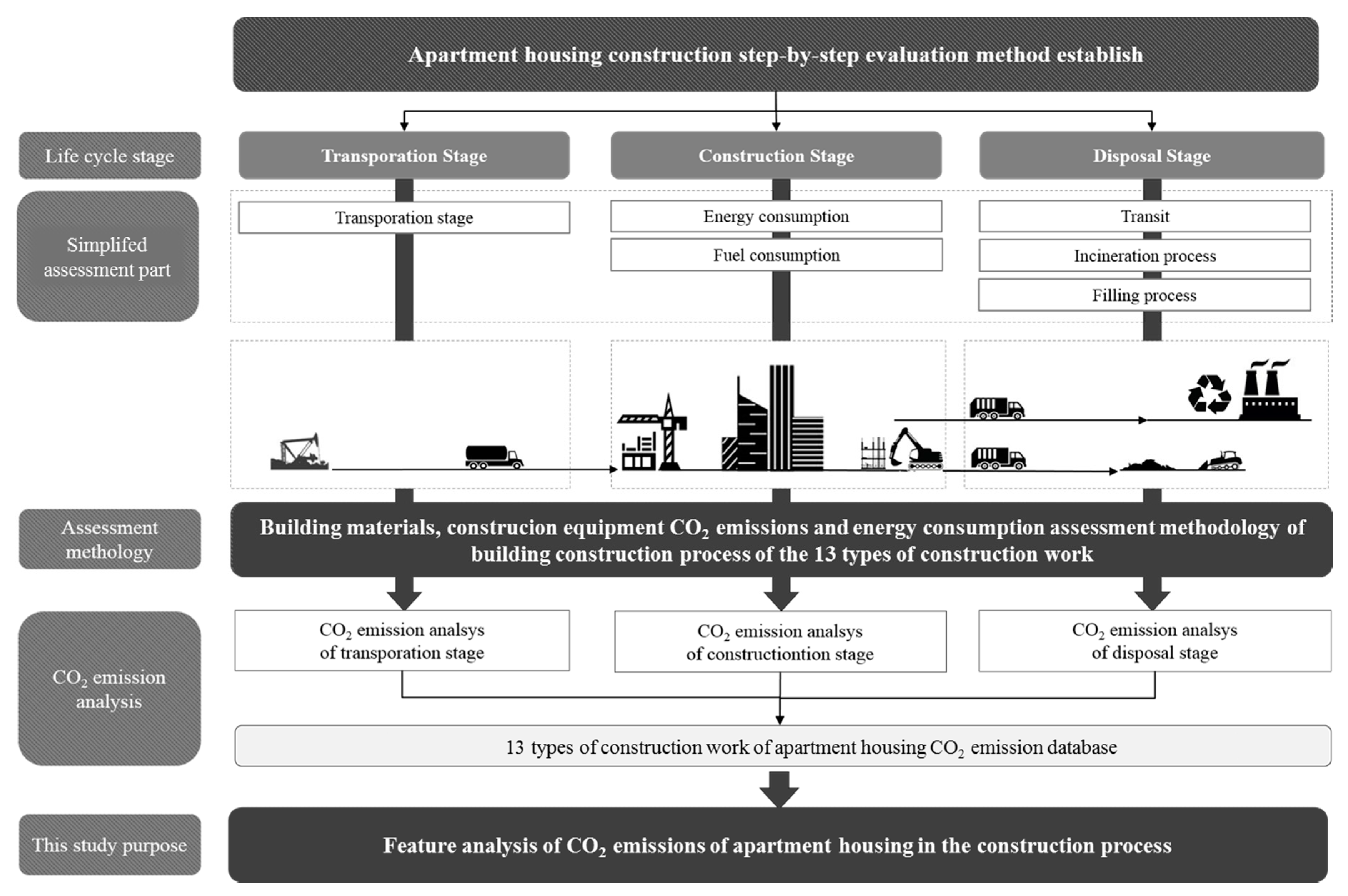
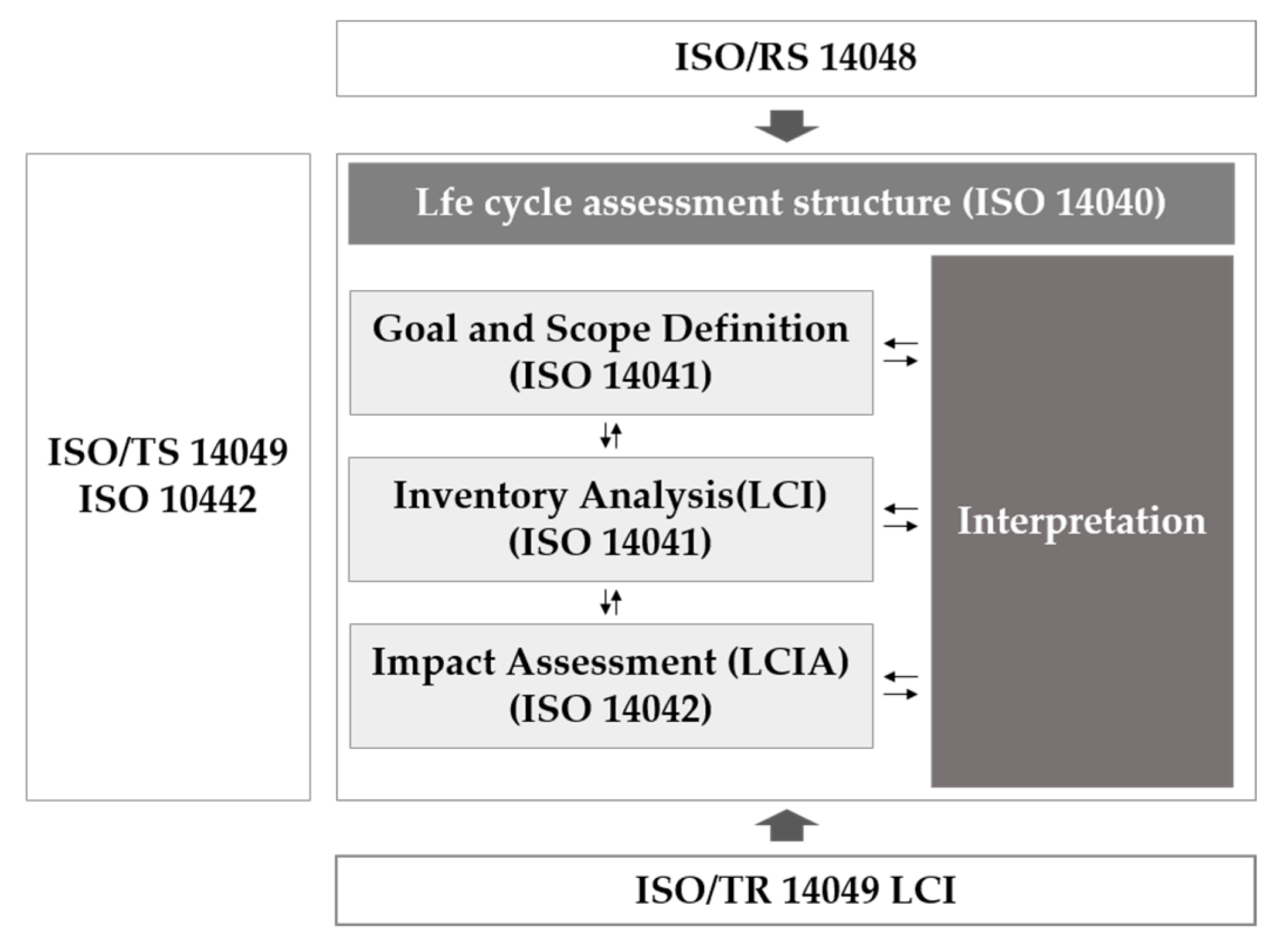

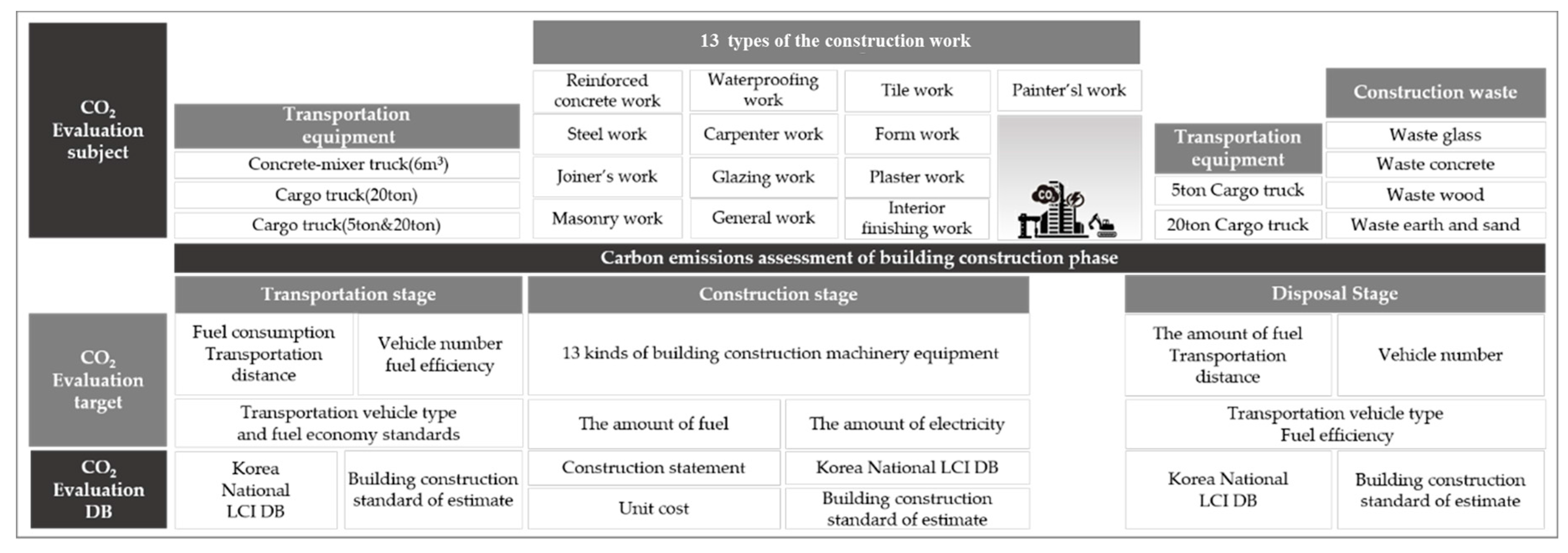
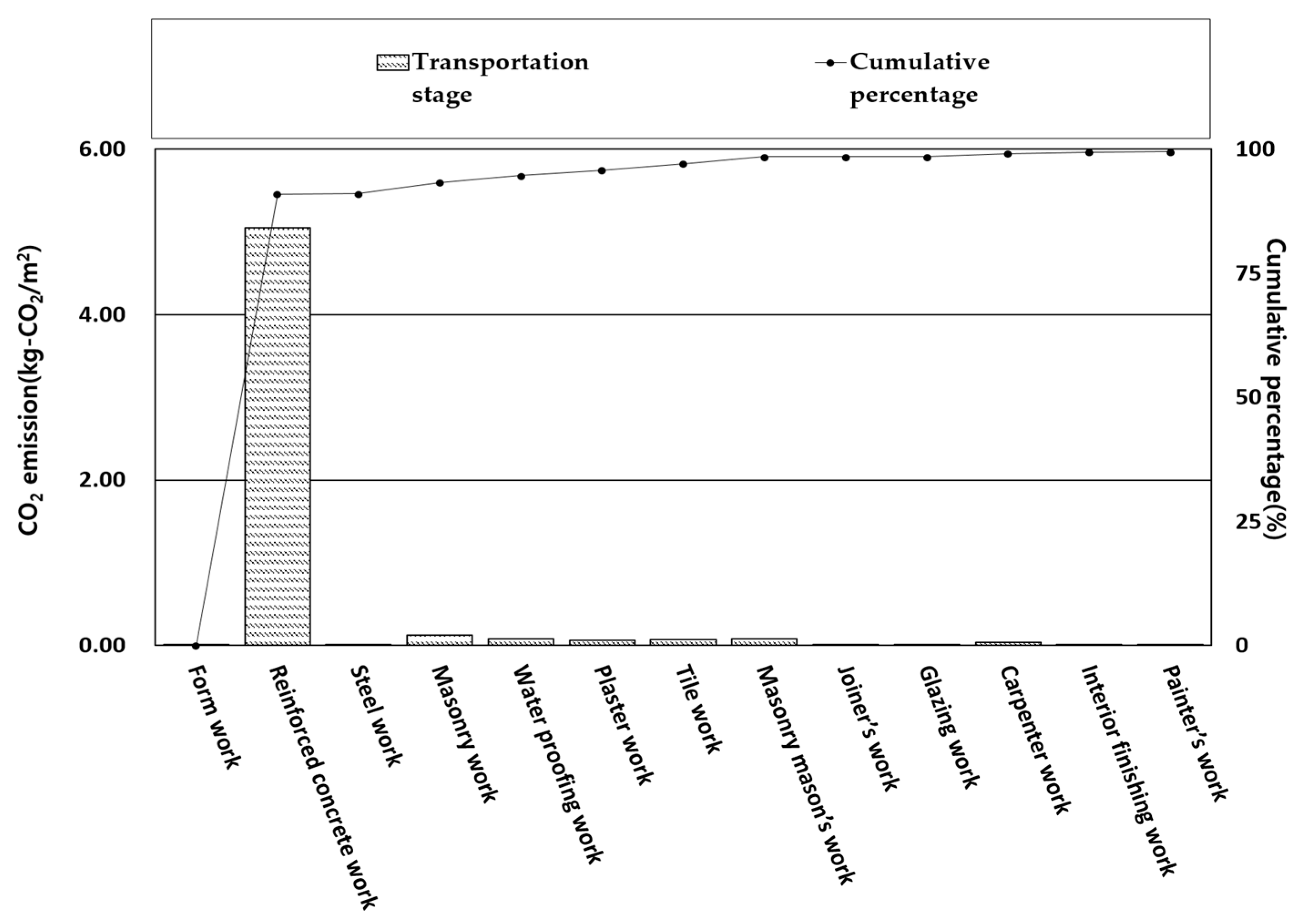
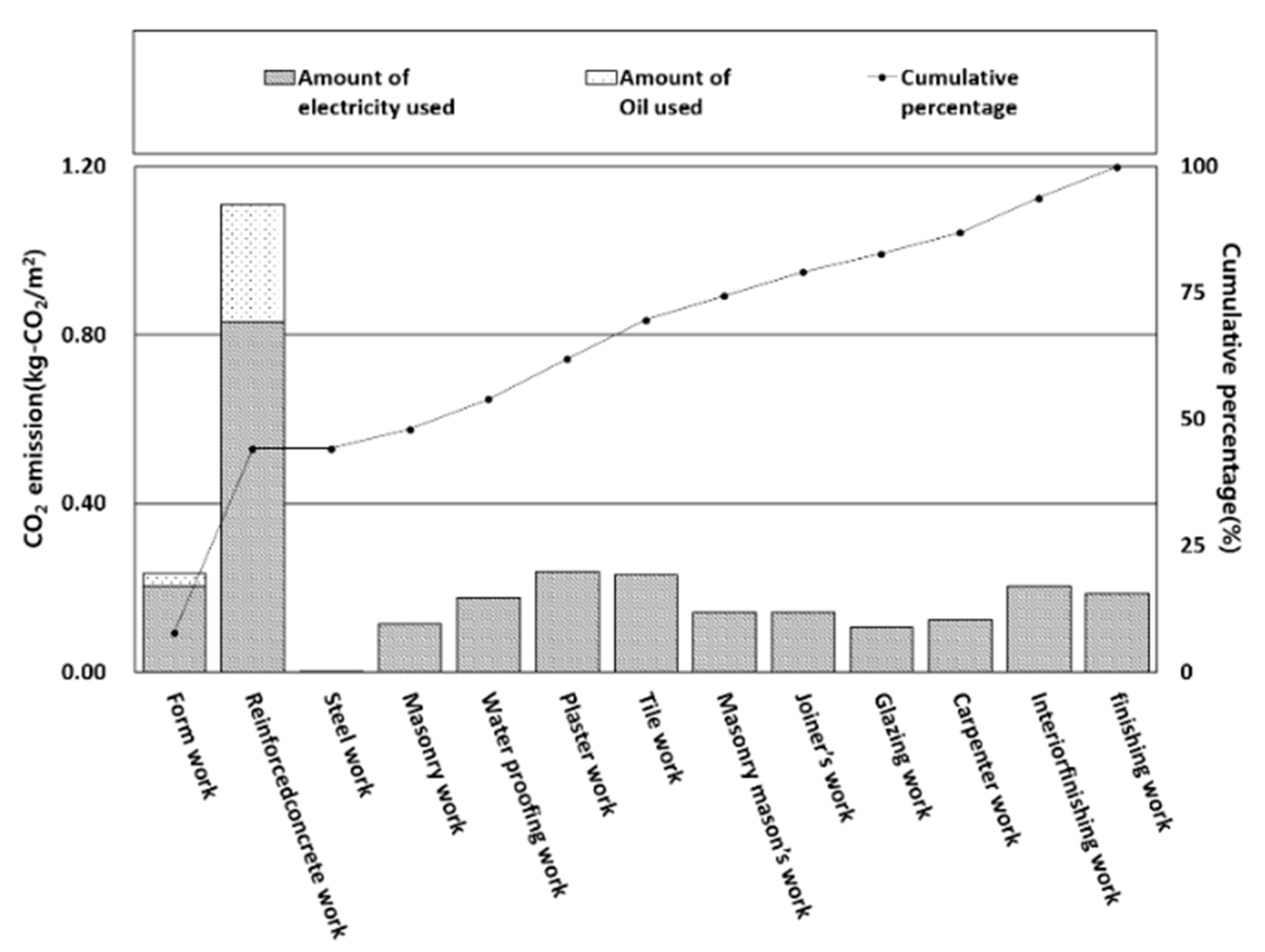
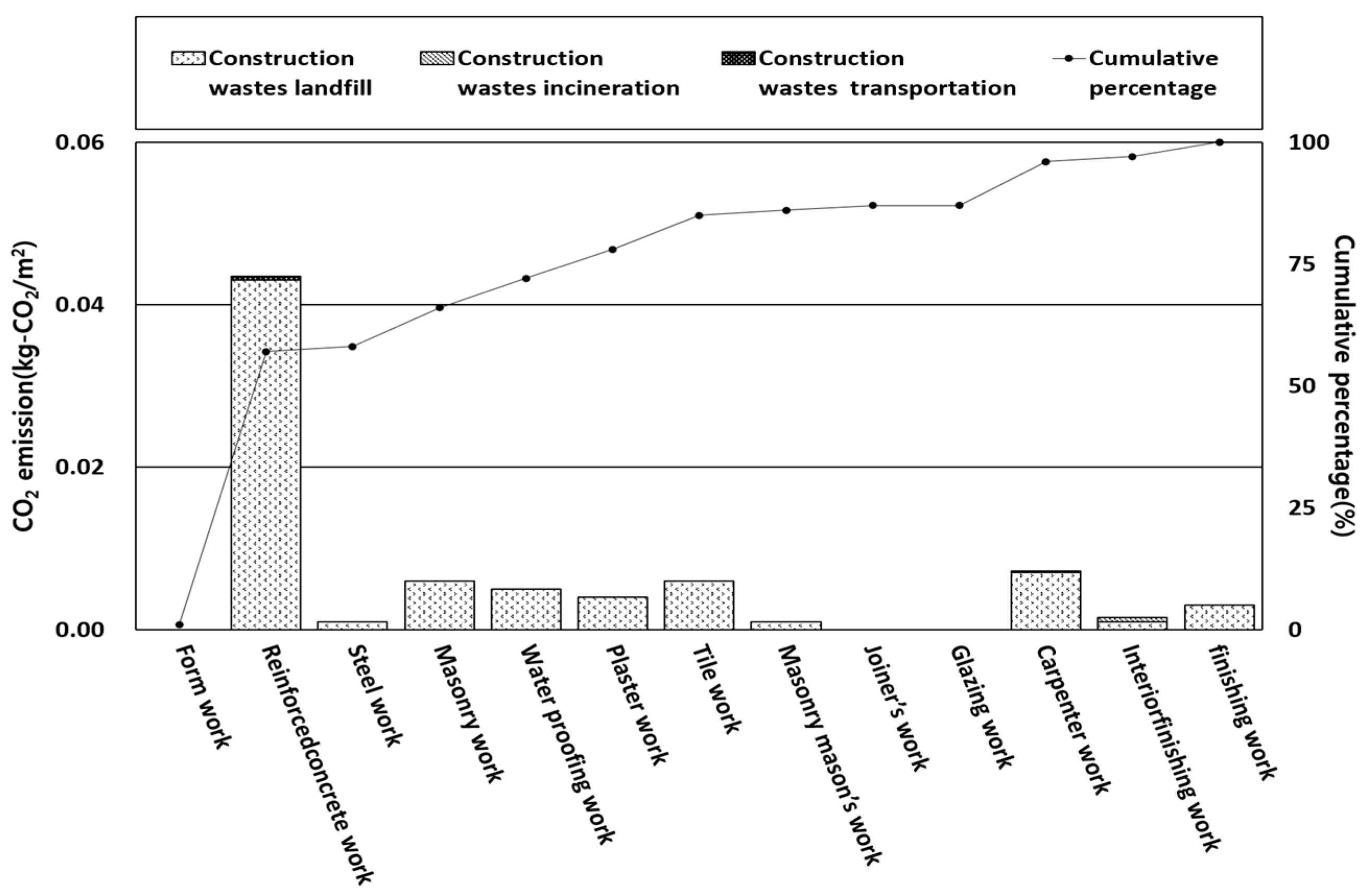

| Division | Summary | Analysis Target | Analysis Method | |||
|---|---|---|---|---|---|---|
| Transit Equipment | Construction Equipment | Construct Work | Input Material | |||
| Hadjimitsis, D.Gand et al. | Environmental Impact and Energy Consumption of Transport Pavements in Cyprus | ■ | Budget statement by district Industry-related analysis | |||
| Murat K et al. | Life Cycle Assessment and Optimization-Based Decision Analysis of Construction Waste Recycling for a LEED-Certified University Building sustainable | ■ | Quantity calculation sheet Industry-related analysis | |||
| Choi MS et al. | Calculate unit cost for building materials input by type of apartment building construction | ■ | Quantity calculation sheet Industry-related analysis | |||
| Kim JY et al. | Analysis of energy consumption for construction materials and calculation of CO2 emissions | ■ | Quantity calculation sheet Industry-related analysis | |||
| Jeong YC et al. | A Study on the Appropriateness of the Application of the Input-Output Table according to the Calculation of CO2 Emission Unit Value by Major Materials | ■ | Quantity calculation sheet Industry-related analysis | |||
| Kim DH et al. | A Study on the Estimation of Energy Consumption and Carbon Dioxide Emission of Building Materials Entered by Construction Type | ■ | ■ | Quantity calculation sheet Industry-related analysis | ||
| Kim KW et al. | Investigation and analysis of the influence factors of oil consumption on building equipment and materials during construction phase of apartment house | ■ | ■ | Industry-related analysis | ||
| Kim JW et al. | A Study on the Development of CO2 Evaluation Method for Concrete Liquefied Transportation in the Construction Phase of Apartment Buildings | ■ | Industry-related analysis | |||
| Input Materials | Transportation Vehicle | Transportation Distance |
|---|---|---|
| Concrete | Concrete-mixer truck (6 m3) | 40 km |
| Steel | Cargo truck (20 ton) | 40 km |
| Subsidiary material | Cargo truck (5 ton and 20 ton) | 40 km |
| Description | Contents | Description | Contents |
|---|---|---|---|
| Business name | Seoul M Urban Development Project | Structural system | Reinforced concrete, bearing wall structure |
| Local district | Semi-residential area | Building type | Flat-type and tower-type Apartment |
| Architectural drawing | Apartment house | Household number | 1004 Household |
| Building scale | 16 stories above ground/2 stories below ground | Land area | 5,633,600 m2 |
| Number of buildings | 13 buildings | Total floor area | 20,839,380 m2 |
| Stage | Emission Factor | Category | Input Breakdown by Work Type | ||||||||||||||
|---|---|---|---|---|---|---|---|---|---|---|---|---|---|---|---|---|---|
| Machine Equipment | Equipment Specification | Unit | Form Work | Rein-Forced Concrete Work | Steel Work | Masonry Work | Water Proofing Work | Painter’s Work | Tile Work | Masonry Mason’s Work | Joiner’s Work | Glazing Work | Carpenter Work | Interior Finishing Work | Finishing’s Work | ||
| Transportation stage | Oil | Cargo truck | 5 ton | N | - | 8 | 4 | 2 | - | - | 296 | - | 14 | 21 | - | 126 | 59 |
| 20 ton | N | 41 | 1618 | - | 578 | 474 | 368 | 237 | 96 | - | - | 219 | - | - | |||
| Mixer truck | 6 m3 | N | - | 30,422 | - | - | - | 14 | - | - | - | - | - | - | - | ||
| Construction stage | Oil | Backhoe | 0.6 m | N | 15 | 2 | - | - | - | - | - | - | - | - | - | - | - |
| 0.8 m | N | 12 | - | - | - | - | - | - | - | - | - | - | - | - | |||
| 1.8 m | N | 3 | - | - | - | - | - | - | - | - | - | - | - | - | |||
| Pump car | 36 m | N | - | 221 | - | - | - | - | - | - | - | - | - | - | - | ||
| 52 m | N | - | 9 | - | - | - | - | - | - | - | - | - | - | - | |||
| Mobile crane | 100 ton | N | - | 18 | - | - | - | - | - | - | - | - | - | - | - | ||
| 50 ton | N | - | 62 | - | 2 | - | 1 | 1 | 3 | 2 | 1 | - | 1 | - | |||
| Dozer | 6 P | N | 2 | - | - | - | - | - | - | - | - | - | - | - | - | ||
| Electricity | Site electric power consumption | kwh | 46,725 | 190,965 | 11,642 | 26,410 | 40,630 | 54,851 | 52,820 | 32,504 | 32,504 | 24,378 | 28,441 | 46,725 | 42,662 | ||
| Disposal stage | Oil | Cargo truck | 20 ton | N | - | 286 | 1 | 29 | 24 | 20 | 13 | 5 | - | - | 11 | - | - |
| Landfill waste | Construction wastes | kg | - | 1228 | - | 2370 | - | 180 | - | - | - | - | - | - | - | ||
| Combustible wastes | kg | - | 4123 | - | 876 | - | 7071 | - | - | - | - | - | - | 5982 | |||
| Incombustible wastes | kg | - | - | - | - | - | - | 13,334 | - | - | 208 | - | 14,439 | - | |||
| Incineration waste | Construction wastes | kg | - | - | - | - | - | - | - | - | - | - | - | - | - | ||
| Combustible wastes | kg | - | - | 1176 | - | - | - | - | - | - | - | - | 2815 | - | |||
| Incombustible wastes | kg | - | - | - | - | - | - | - | - | - | - | - | 199 | - | |||
| (Unit: kg-CO2/m2) | ||||
|---|---|---|---|---|
| Stage Classification | Transportation Stage | Construction Stage | Disposal Stage | Total |
| Form work | 0.001 | 0.258 | 0.000 | 0.259 |
| Reinforced concrete work | 5.053 | 1.198 | 0.043 | 6.294 |
| Steel work | 0.003 | 0.001 | 0.001 | 0.005 |
| Masonry work | 0.125 | 0.127 | 0.006 | 0.258 |
| Water proofing work | 0.077 | 0.195 | 0.005 | 0.277 |
| Plaster work | 0.061 | 0.264 | 0.004 | 0.329 |
| Tile work | 0.070 | 0.253 | 0.006 | 0.329 |
| Masonry mason’s work | 0.016 | 0.157 | 0.001 | 0.174 |
| Joiner’s work | 0.001 | 0.156 | 0.000 | 0.157 |
| Glazing work | 0.002 | 0.119 | 0.001 | 0.122 |
| Carpenter work | 0.036 | 0.138 | 0.007 | 0.181 |
| Interior finishing work | 0.013 | 0.225 | 0.001 | 0.239 |
| Painter’s work | 0.006 | 0.205 | 0.003 | 0.214 |
| Total | 5.463 | 3.295 | 0.078 | 8.838 |
© 2018 by the authors. Licensee MDPI, Basel, Switzerland. This article is an open access article distributed under the terms and conditions of the Creative Commons Attribution (CC BY) license (http://creativecommons.org/licenses/by/4.0/).
Share and Cite
Lee, J.; Tae, S.; Kim, R. A Study on the Analysis of CO2 Emissions of Apartment Housing in the Construction Process. Sustainability 2018, 10, 365. https://doi.org/10.3390/su10020365
Lee J, Tae S, Kim R. A Study on the Analysis of CO2 Emissions of Apartment Housing in the Construction Process. Sustainability. 2018; 10(2):365. https://doi.org/10.3390/su10020365
Chicago/Turabian StyleLee, Jonggeon, Sungho Tae, and Rakhyun Kim. 2018. "A Study on the Analysis of CO2 Emissions of Apartment Housing in the Construction Process" Sustainability 10, no. 2: 365. https://doi.org/10.3390/su10020365





